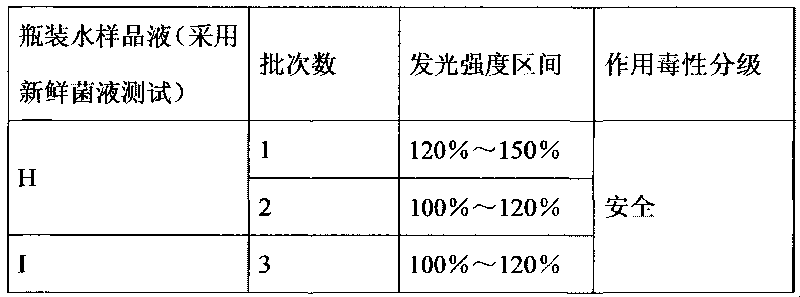Detection method for acute biological toxicity of drinking water contained in plastic bottle
A biotoxicity and detection method technology, applied in the direction of microorganism-based methods, biochemical equipment and methods, microorganism measurement/inspection, etc., can solve the problem of changing the physical and chemical characteristics of samples, affecting the accuracy of testing, and the rapid safety of bottled water that has not yet been seen. detection and other problems to achieve the effect of ensuring correctness and fast detection speed
- Summary
- Abstract
- Description
- Claims
- Application Information
AI Technical Summary
Problems solved by technology
Method used
Image
Examples
Embodiment 1
[0025] 1. Preparation of bacteria solution for test
[0026] 1. Preparation of fresh bacteria solution:
[0027] Use the slant bacteria of the Qinghai Vibrio Q67 strain mentioned above, transfer it to a fresh slant, and incubate at 15-25°C for 12h-18h. At this time, the bacteria glow brightly. Use 10ml of 0.85% NaCl solution to gently wash the bacterial lawn from the slant. , shake well, adjust the concentration of the bacterial solution with a small amount of normal saline to make the concentration of the bacterial solution OD 660 ≈0.3 or so, take 0.1ml of bacterial liquid, add it to a sample test tube with 2ml of normal saline, use a photometer to detect the luminescence, when the luminous intensity is 2-5 million photons / second, this fresh bacterial liquid can be used as a test Bacteria used.
[0028] 2. Preparation of freeze-dried powder bacterial solution:
[0029] Add 5ml resuscitation solution to the freeze-dried powder of Vibrio Qinghai Q67 strain, mix well, and pla...
Embodiment 2
[0042] Bottled distilled water water quality toxicity testing:
[0043] 1. Sampling
[0044] (1) Take distilled water samples directly: take an appropriate amount of bottled distilled water, and add NaCl to a final concentration of 0.8%.
[0045] (2) For the control of the blank water sample, the sub-boiling point distilled water that was double-distilled was used, and NaCl was added to the final concentration of 0.8%.
[0046] 2. Luminescence detection
[0047] The BHP95114 water quality toxicity analyzer produced by Beijing Hamamatsu Photon Technology Co., Ltd. was used as the test instrument.
[0048] You can use freeze-dried powder bacterial liquid, you can also use fresh bacterial liquid.
[0049] Prepare three test small cups, add 2ml of distilled water samples to each small cup, set up three parallel samples, and take three test small cups for blank water sample control, add 2ml each, and set up three parallel samples, each Add 0.1ml of fresh bacterial solution or 0...
Embodiment 3
[0055] Inspection of bottled natural mineral water
[0056] 1. Sampling
[0057] (1) Take mineral water directly to prepare the sample solution: use an appropriate amount of bottled natural mineral water, and add NaCl to a final concentration of 0.8%.
[0058] (2) Preparation of blank control sample solution: use sub-boiling point distilled water re-distilled twice, and add NaCl to a final concentration of 0.8%.
[0059] 2. Luminescence detection
[0060] Prepare three small test cups, add 2ml of mineral water sample solution to each small cup, and set up three parallel samples; take three test small cups for the control sample solution, add 2ml each, and set three parallel samples in turn. Add 0.1ml of fresh bacterial solution or 0.05ml of freeze-dried powder bacterial solution as the test bacterial solution. The time interval for adding bacterial solution to each test small cup is 15s. Luminous Intensity, to calculate the relative luminous intensity.
[0061] 3. Calculat...
PUM
| Property | Measurement | Unit |
|---|---|---|
| Light intensity | aaaaa | aaaaa |
Abstract
Description
Claims
Application Information
 Login to View More
Login to View More - R&D
- Intellectual Property
- Life Sciences
- Materials
- Tech Scout
- Unparalleled Data Quality
- Higher Quality Content
- 60% Fewer Hallucinations
Browse by: Latest US Patents, China's latest patents, Technical Efficacy Thesaurus, Application Domain, Technology Topic, Popular Technical Reports.
© 2025 PatSnap. All rights reserved.Legal|Privacy policy|Modern Slavery Act Transparency Statement|Sitemap|About US| Contact US: help@patsnap.com



